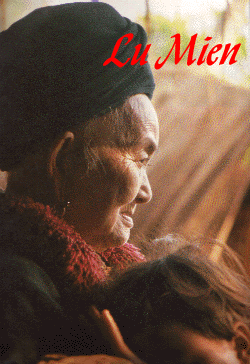
by Meay Saechao
“Instead of living on mountain-tops, they live in apartment complexes, and instead of engaging in subsistence swidden agriculture, they cash AFDC checks, and are employed at carwashes and other menial jobs” (Waters 128).
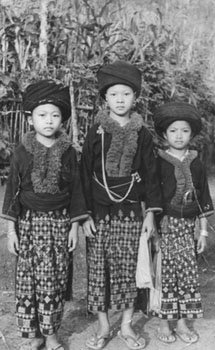
The United States is a country of immigrants from many different nations and all walks of life. We live in a diverse society, yet, our nation’s culture is that of the Anglo-Saxon culture, the “normal” culture, the one that all is expected to adopt. Asian immigrants, in particular, face many challenges upon arrival into the United States due to the presence of cultural differences. The Asian culture, regardless of the exact ethnic group of the Asian, is of complete difference from that of the Anglo-Saxon culture. The difference is as clear as day and night. The languages, the dress, the physical and mental characteristics of the two groups are so distinct, that there is no doubt of differences. Upon this, I introduce to you the Mien minority group of Asia. They are a small group of people from Asia, whose exact origin is unbeknownst to many, including themselves. However, they are Southeast Asians, and like many other Southeast Asians, they have the most difficulty adjusting to American mainstream compared to Chinese and Japanese immigrants. They are a very recent group to the United States, and the first wave of Mien people into the United States was not immigrants but refugees of war. Unlike the Chinese and Japanese who have been here for a long time, the Mien refugees are new and unknown to the American natives, which makes it all the harder to adjust and adopt to the American mainstream due to lack of available resources. The difference between immigrants and refugees is that immigrants choose to come, and refugees are forced to come for fear of their home country.
History and Origin
"The Mien people are swidden farmers traditionally found in southern China and Southeast Asia where they have always maintained their ethnicity as a dispersed minority among larder dominant groups. Since 1980, however, a small group of about 10,000 has been resettled in the United States, as refugees who have fled the aftermath of the Laotian Civil War (1954-1975)” (Waters 127).
Life in America is hard for immigrants, especially those from Asia. From the time of departure from their home country to the time of initial landing, they fear what the yare stepping onto. Their minds caught in a web of confusion because both excitement and fear creeps in their mind. They are excited about this new country, and at the same time, they are uncertain of what awaits. But for the refugees, the feeling is a bit different. Yes, they are fleeing from dangerous grounds, but they do not have a choice. It was either to stay back and face death, or move to this new country and start all over again from scratch, in a land that was as unfamiliar to them as the new faces. The Mien refugees faced many obstacles before coming to America and even greater ones once they arrived. “The Iu-Mienh people are one of six ethnic groups that have for centuries been called ‘Yao’ by the Chinese, Southeast Asians and others” (“Callaway”). But the Mien people discarded the term “Yao” because it means “barbarians,” which the Chinese called anyone that was not of the Han clan. The term Iu-Mienh means “the people,” so many Mien people just call themselves Mien, which is used by many Americans and other Asian groups. Mien people are said to be descendants of people from Chain, but their origin is still a mystery because they have no written language of their own and their history passed down from generation to generation orally. History has it that they were forced out of China because of feuding over control of lands, during the end of the Ching dynasty. They were tribal people who lived in villages throughout southern China, Laos, Thailand, and Vietnam surviving upon slash and burn agriculture.
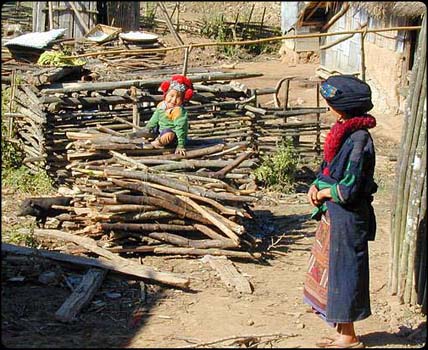
“The Iu Mien were self-sufficient people with a very simple but rich lifestyle. They occupied small villages of thirty to one hundred people, living in very simple dwellings made of bamboo walls and thatch roofs. The average family possessed two tin pots for cooking rice and vegetables, a wooden rice bowl, and a pair of chopsticks for each member of the family. Their main diet consisted of rice, corn, grown vegetables, and wild plants. They made their own clothing from cloth obtained through trade or purchased from local weavers. They had very little contact with the outside world” (“Chao”).
Today, Mien people live throughout the world in small numbers, the largest still in Southeast Asia. There are Mien people in the United States, where the second largest Mien population is found, also in Alaska, Canada, France, Denmark, New Zealand, and possibly Australia. The first wave of Mien people arrived into the United States between 1978 and 1980 as refugees, shortly after the collapsed of Laos. However, before this large wave, there were a few families that came prior to 1978, the earliest known date is 1975. Some came with only the clothes on their backs, while the majority of them had some valuables, but none that was worthy anything in the United States. Because they did not plan on such a move, they came unprepared, not knowing what they were getting themselves into. The majority of the Mien refugees settled in the west coast, along the coasts of California, Oregon, and Washington. Those that had came a year or so earlier, were able to help out the ones that came later, but not with much because they themselves had not much to begin with. Because they were the first Mien to have settled in the United States, there were no governmental programs available to help them, nor were there interpreters that could translate the English language into something that they would be able to understand. This new world was like walking in the dark without lights. Everything was of complete utterances; the new faces, the gibberish that came out of these new faces, the way these people were dressed, the abundance of automobiles, large and small, the tall buildings that seemed as though they would collapse on you at any given moment, and the multiple rooms in these buildings, complete with weird objects.
Life in America
Culture shocked! The refugees were overwhelmed with new objects everywhere that they turned. They all lived together in little communities, one helping the other, like they had in their home country. They were unable to obtain work because they lacked sufficient English. Many of the Mien people had never held a pencil or pen in their life because they speak an unwritten language, which meant that for many their first experience with a writing utensil might have been established with their first experience in America. In their non-technological homeland they were able to fend for themselves, but here in America it is different because not only do they not own their own farmland, their knowledge and skills of farming and raising animals are non-marketable.
“Many Iu Mien people are experiencing great difficulty adapting to the American way of life. Acculturation is much more stressful for refugees than immigrants or native persons because, unlike immigrants, refugees do not come by choice and, unlike native people, refugees do not have an established territory and culture in place to support the individual” (“Chao”).
In California, where the majority of the Mien refugees settled into communities around the Bay Area, groups of Americans from nearby churches became interested in these new people that they had never heard about. They went into the communities and befriended the Mien immigrants, providing them with food and clothes items from church collection. Soon, people were coming from all professions interested in learning more about these people. Professors and other scholars of the anthropological and sociological academia were interested in learning more about their culture, language and origin, and Christians were interested in converting the Mien to their faith. These Americans helped many Mien families apply for welfare from the government since they were unable to obtain work. Pretty soon, the majority of the Mien population in California and elsewhere in the United States were dependent on welfare.
Employment and Education
Availability of welfare led many to stop their exhausting search for employment, but it is not to say that others did not keep trying. Classes were established by these helpful Americans to try to teach the Mien refugees the English language and writing, but it was hard to do so because they did not know how to translate English into the Mien language. However, since the Mien refugees had once lived amongst Laotian and Thai people, they were able to understand these languages, verbally but not written. Through the help of Laotian and Thai interpreters, they were able to help the American teachers translate some of the lesson plans. Also, some of the older male refugees were able to read and write the Chinese characters, which the Americans took to great use to teach the older male generation.
Although these classes seemed a great success in the beginning, they did not last long because of funding, and lack of effort from the Mien communities. It was not that they did not want to learn English, but they felt hopeless because an education was never a necessity to them, which made it difficult for them to grasp the concept of learning. The first tools they held when they were old enough to talk were those used for fieldwork, not for writing and learning.
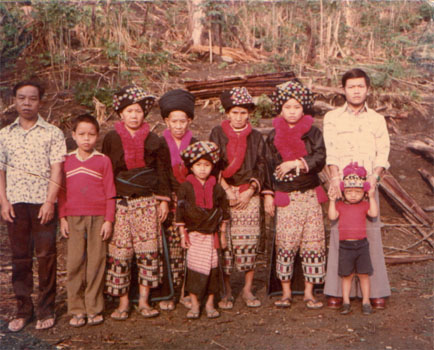
Those that lacked the less efforts found that it was easier to rely on welfare because they felt that there was no hope in them trying to learn something new when their lives were almost over. Some were able to obtain work such as, working on assembly lines at local factories, janitorial work at nearby hotels, hospitals, and offices, while some worked in private homes doing housecleaning, yard work, and putting up fencings. Needless to say, they were working long hard hours for very little pay. Those that were able to learn English decided that it would be best to try to further their education, regardless of their age. Old and young, these motivated groups enrolled at local community colleges and adult schools taking English Second Language (ESL) classes. Those that had a family were unable to afford going to school and support a family because the governmental assistance were just not enough to feed a family, especially since some Mien families were quite large. They felt that it would be better to drop school and look for work because school was not feeding their families. Some tried to work and take night classes, but stress of regular work, schoolwork and family took over, forcing them to put school to a complete halt. Many had promised themselves that when their children are all grown, they would go back to school, but it never happened. Some not only had to take care of their children, but their parents, who were as dependent upon them as were their children because the Mien culture requires that once the children has grown, they must take care of their parents in return for their hard work of rearing them when they were children. They often look back and wished they had never quit school because now they are still working the same line of jobs they have been doing since they first came to the United States, working long hard hours for very little pay, day in and day out. They lose faith because they feel that they cannot change things now that it is too late for anything.
Those that found success in these ESL classes continued on to take other enrichment classes to help with their English, as well as other courses to expand their knowledge. The ones who continued on were still in their young adult years, which enabled them to concentrate more of their time on schoolwork. Many of them did not have children, or family, who they had to take care. If they did, they had parents who were willing to help them raise their family, or they were the youngest child. They continued on with school, some graduated from community colleges and went on to pursue four year colleges, others went on to trade and vocational schools, while the rest took on jobs that only required a community college level education. Today, some of these former students are working in local social service offices helping the Mien community, and many act as interpreters at hospitals, school districts, and local agencies. The younger ones who were able to continue on with four-year colleges are now local teachers, police officers, and other official city workers. They have all succeeded and gone back to help their communities because traditional culture has it that the family and community is more important and must come before the individual.

Those that were able to benefit from an education found it most beneficial and used it to the best of their advantage, but those that did not take the educational route did not find a better life in America. Many Mien people today are very bitter towards the American society because they feel that they have nothing to live for. They are so dependent upon the government, which they feel is not giving them enough public assistants to live on. The ones who received an education, or the little that they were able to grasp, were able to assimilate into the American culture, and appreciate what this country has to offer. Many Mien people today are still very traditional, and leave very little room for the American culture. They feel that they have done their part in raising their children, who should now take responsibilities of the family. They are reluctant to assimilate because they do not consider themselves Americans, nor will they ever become Americans. Many only became American citizens so that they can keep their government assistance coming every month. They have no plans to vote, nor do they wish to obtain work.
Mien children: struggles with education and biculturalism
The refugee children of the first wave, on the other hand, were able to enroll in school. These children were young enough to start their education with elementary school and ascend through the American school system, enabling them to consume new knowledge with ease. Upon completion of elementary school, they continued on to middle school and then high school because unlike their older counterparts they did not have a family to support. The majority of these refugee children were fortunate that they had come at such a young age because they were mostly under 12 years of age, the perfect time to learn new things and be able to absorb the knowledge without struggle.

Education was not part of the Mien culture. It was not supported nor enforced by the refugees, even here in America, because an education was not of importance in their homeland, so many did not understand the benefits behind a good education. This false notion lead many of the Mien refugees to support that their children look for jobs and help support the family. In their homeland, it was customary for children to marry as young as 14 years of age. Many parents even still practice arrange marriages in the United States because they want their children to have children and carry on the family name. Many parents swear that they will not die until they know their name will be kept alive years from now.
Ignorance plays a major role with the Mien people. Those adults that did not pursue an education, and instead lived on welfare from day one, encourages their children to start a family now when welfare is still available to them. Because of this, many refugee students of the first wave did not complete high school. Instead, many start families of their own and entered the welfare cycle that their parents are still in. Young girls have children out of wedlock because premarital sex is practiced and encouraged in the Mien culture. Now you have all these young children having children of their own and no education, which is one of the worst combinations you can have in the United States because an education is such an essential part of our society. Those children that come from less traditional families tend to continue on with their education, but this number is very small. Unfortunate to say, very few actually graduate from high school, and even fewer continue on with college. Sometimes the parents may be very supportive of their children’s education, but the rest of extended family and community may be in total opposition. They feel that schools fill the students’ heads with useless nonsense and that it is better to work and support the family. They do not understand the many opportunities that an education will provide in the future, nor do they want to open their minds and understand. Mien people are very arrogant and stubborn, so what they think is what is right, which in this case – an education is unnecessary. This makes it all the harder on the students because not only is school difficult, but also their family and relatives are discouraging.

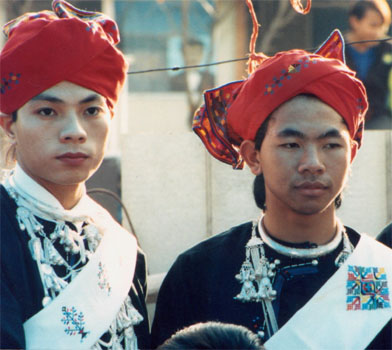
These children usually grow up bicultural. Regardless of what kind of education they have, these children are faced every day with their Mien culture while at home, and encounter the American culture while away form home and with their American friends. Those that associate with Mien friends have less stress with biculturalism because their friends do not impose new things upon them. These that associate outside of their kind are often faced with much difficulty because they do not know which way to turn. These are normally the ones who have decided to pursue an education, and taken it seriously. These are the ones with the most stress because not only are their families against their decision for a higher education, but they are also ridiculed about not keeping alive their culture and traditions. Because they are experiencing new things, they want to be able to drift from the family and be their own person. They are in desperate need for their own identity, and it is hard to do so when they live at home. Even the parents, who have assimilated slightly into the American culture, still cannot understand the entire culture, besides the important fact that an education is of great importance.
“Intergeneration conflicts during this stage mostly concern issues of extra familial relationships, self expression, and fulfilling their future adult responsibilities. There is a consensus among the young adults that their parents are very unsympathetic to their needs as teenagers. They feel that their parents impose too much of their traditional values on them and do not try to understand their feelings. They feel that their parents were too critical about their friends, their style of dress, and the things they do for fun.
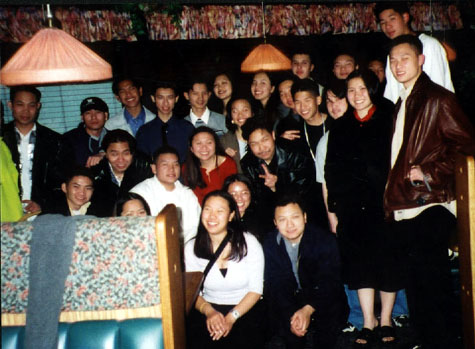
In Iu Mien culture individual independence is not recognized. Children are born into a web of family ties, which are maintained for the rest of their lives. The mutual dependency among their family is based on traditional Iu Mien culture, and results from several factors. First, in a non-technological agricultural society collective effort is a survival skill; second, family identity takes precedence over individual identity; third, the Iu Mien religious system is such that a person is forever bound to his extended family; fourth, a person is not recognized as an adult until he is married; and fifth, in the parent-child relationship, the offspring maintain the status of a ‘child’ regardless of age and social standing. Thus, a fifty-year-old man is still seen as a child to his seventy-year-old parents” (“Chao”).
This biculturalism sometimes causes Mien children to form bitterness towards their own family and people because their views conflict, and no one seems to neither understand nor accept their differences. Because Mien parents grew up in a completely different environment and cultural system, it is hard for them to understand what their children are going through. Most mien parents are also very strict because they feel that although they live in America, they are still Mien people and it is not an excuse to stray from traditional ways. Many expect that their children either work or go to school, and when they are home, to keep with household duties. Young adult males are expected to participate in religious ceremonies, help provide for and maintain the household. The young adult females are expected to tend to household chores and prepare for a future as a housewife. Even if a female is educated she is still considered second to her husband and must do as he say because she will never be thought of as smart than he.
Those who have decided to take a chance and stray from traditional norms usually face many consequences, which are not only inflicted on the individual but also on the whole family. The ones who are in school are ridiculed for trying to be better than his or her people. Sometimes the grandparents and extended families of students insult and reject them, in hope that this would discourage such nonsense. If the student were female, people would gossip that the student only want sot go to school to meet American boys because they are said to be better equipped. The parents of these school girls are afraid that if their daughters continue on with school, they may not be able to find suitable husbands later in life to take care of them, not realizing that these girls would gain independence from a good education.
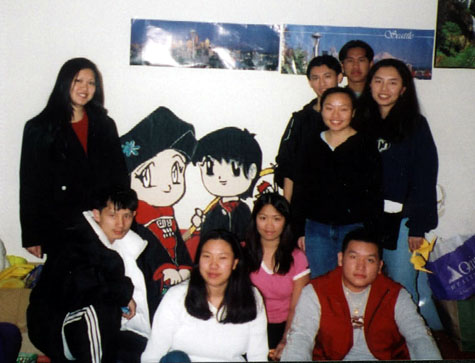
Sometimes the few students who are attending four year colleges feel abandoned by their own families because not only is their community rejecting them, but their family as well, for not coming into their defense. I was fortunate to have parents who encouraged my pursuit for a higher education. All throughout my grade school year, my parents have repeatedly assured me that they will support me all the way. They were not able to obtain an education because they had to work all their lives, and when they arrived in the United States they had to begin earning to support the family, which included my grandparents and my father’s younger brother. My parents tried to go to school when they first arrived here, but stress soon caught up with them, forcing them to quit. When I wanted to go away for school, my grandmother told me that I would never make it. She refused to attend my high school graduation, so my father had to practically drag her. Although my extended family disagree with the idea of my education and tried to convince my parents to stop me from going any further, my parents just simply ignored them and faced the ridicules. When I decided that I wanted to transfer here to New York, my relatives were in hysteria.
I am among the few that have reached the four-year college level, which has been a long and hard struggle. I only have two Mien friends because there were hardly any Mien students during my school years, but I did not meet them in school, either. They are also college students; one is graduating this may and pursuing graduate school in Arizona. We often get together and talk about how we can help our people, but often times we feel that we can not help because they do not want our help. They do not want to change, nor do they feel the need. And why help them, when all they did was ridiculed us for wanting an education. We often lose hope in our own people because we see that they are not trying to get out of their little communities and lack any sign of motivation or desire for upward mobility. Those refugee children of the first wave, who had started school when they were young, like me and my friends, are now successful but they do not return to the communities because they feel the same way we do. I seem to have contradicting feelings towards my people. I feel that maybe they just need more motivation and support, and maybe then they will see that there are many opportunities and benefits out there for them. Sometimes, I ask myself if I really want to help these people that once treated me so badly, but when I really think about it, no one else has really tried to push them in the right direction.
Each and every day, articles are printed in local newspapers about the Mien communities, and although most of the articles bring bad news, the few that bring good news offers hope for my people. It is looking better and better every year because more and more Mien students are enrolling in college. Although the numbers are still very low compare to other groups, it is liberating to see that the numbers are rising. The Mien people have always been hard workers, but coming to this new land, they lost that spark of motivation that they once held in their homeland, which they just have to find again. It is not that Mien people are lazy, but because they have lost all hopes when they were forced to leave a land they loved. Mien people are not so much immigrants, but casualties of war.
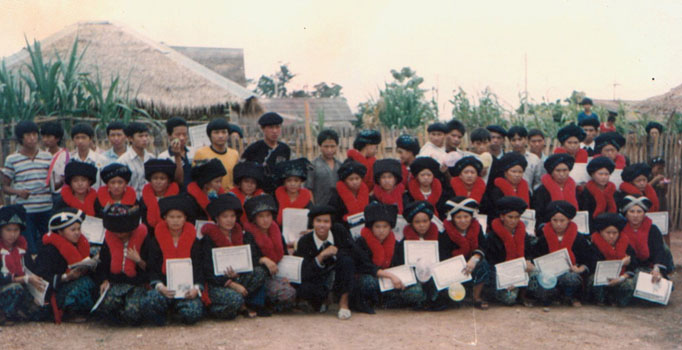
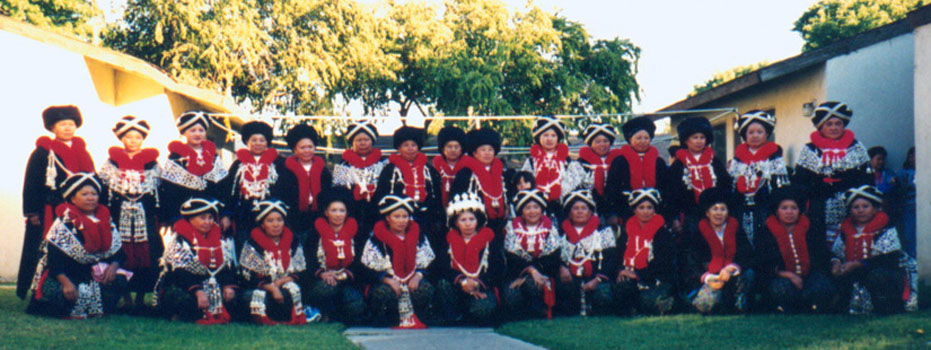
Mien women here in the United States wearing the traditional Mien attire decorated with silver chains and ornaments, which is an indication of wealth.
*I do not claim neither ownership nor creation of the pictures on this page, for they have been obtained from other websites.